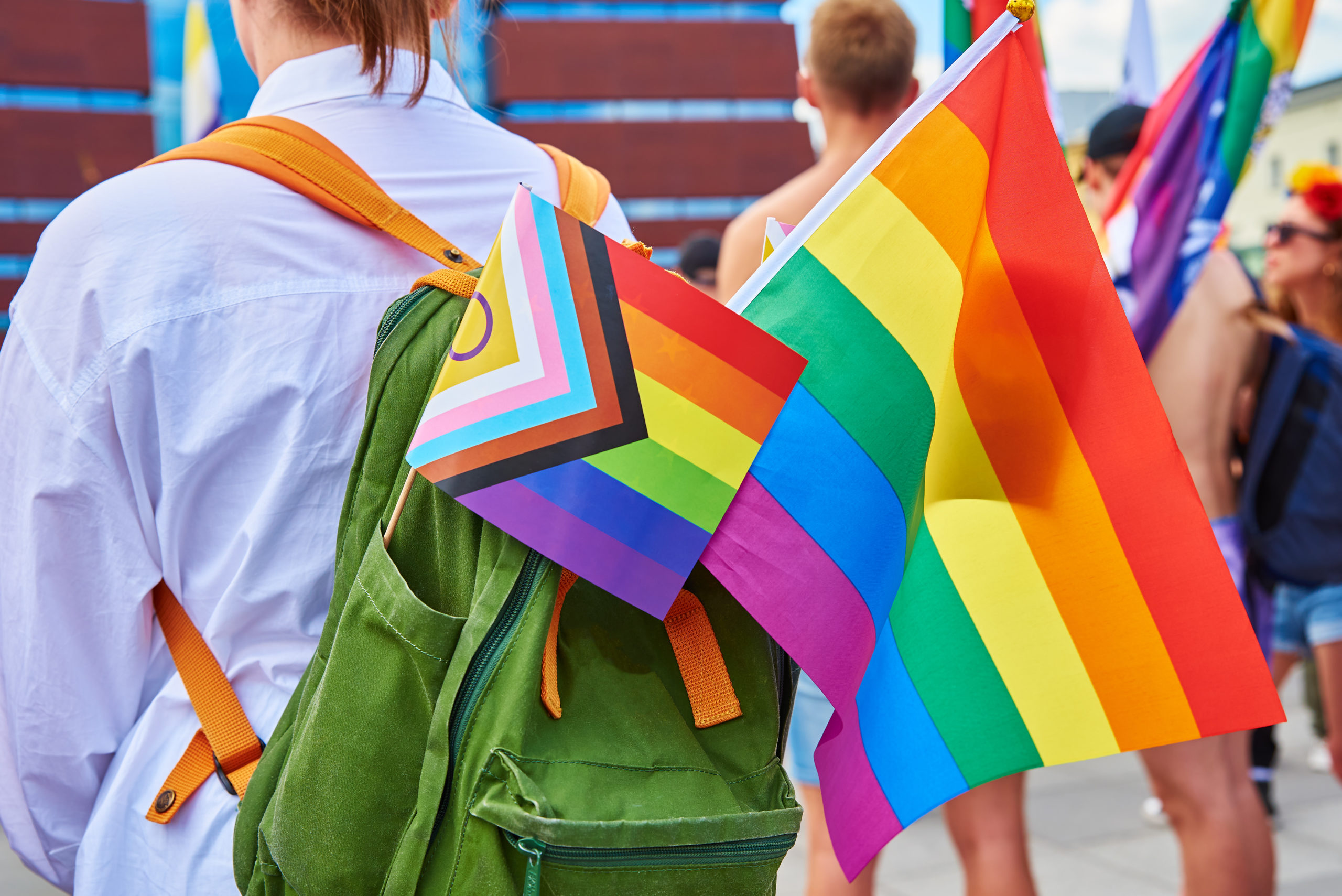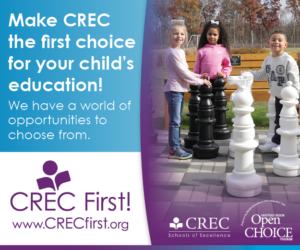What’s changed and what still needs to be
changed to make everyone feel welcome
BY Dawn Ennis
Autumn always brings change, not just to trees and temperatures but to our lives. Across Connecticut this year, the season’s fall colors appear ever more vibrant as the backdrop for more and more rainbow flags popping up on our college and university campuses.
Students who identify as LGBTQ+ tell CT Voice these varied symbols of Pride send a message: “You matter. You’re an essential and integral part of campus life. You are welcome here.”
“You see the world differently, as a queer person, versus as a straight person,” said 19-year-old Mellody Massaquoi, a junior studying social work at Southern Connecticut State University in New Haven, where an out gay man, Joe Bertolino, is president.
They talked about how, as a Black bisexual person, intersectionality is respected on campus.
“I can’t really leave my Blackness at the door, especially if I enter queer spaces,” Massaquoi said. “It’s not that I’m just bisexual. It’s not that I’m queer, I’m also Black. And that experience still matters. Especially when we look at different spaces and how straightness is accepted while queerness is not. I’m very fortunate at Southern that there are queer spaces, like the SAGE Center and Prism.”
The SAGE Center is committed to providing a positive academic, cultural, and social environment for Southern’s LGBTQ+ community and Prism is an undergraduate student club dedicated to boosting educational awareness of the wide variety of sexualities and identities across the SCSU campus.
Those kind of safe havens for lesbian, gay, bisexual, transgender and queer students have become as common as STEM and the model U.N. clubs at universities.
“When I graduated high school in 2013, people were accepting of gay people. But it wasn’t as it is today,” said Angelo Virone, a graduate student at St. Joseph’s University in West Hartford. “Now there’s online social media influencers who are gay, TV shows, books. There are a million different examples of representation, and I think that kind of brought us into the mainstream and made it way more accepting. I wish I grew up in that era,” he said.
Growing up in an immigrant family, Virone said his teen years were challenging in having to confront “traditional Italian values” as a young, out gay man who wasn’t looking for a wife. The Avon resident is now 26 and celebrated his first wedding anniversary with his husband this past summer. His parents took a while, he said, but they came around eventually.
“Just thinking about the difference from when I came out,” Virone said. “I remember my mom being at my wedding, crying and being so happy. She considers my husband another one of her sons.”
What may surprise some is the acceptance Virone said he has found on the campus of his Roman Catholic-run university, St. Joe’s.
“That was like one of the things that I was hesitant about. I was worried that it was going to be more of a religious focus, teaching that ‘homosexuality is a sin,’ and all that kind of stuff with the Catholic religion. But I was surprised,” said Virone, who is studying for his master’s degree in school counseling and will graduate in the spring.
“St. Joe’s has been nothing but accepting and amazing,” he said. “All the professors are just so kind, especially when I talk about my husband. I don’t feel like I have to keep that a secret or anything like that. I definitely think that there’s been a lot of growth in society that made it way more accepting to be gay.”
A gay student working on his bachelor’s degree in management at the University of Hartford’s Barney School of Business asked that we not use his real name for this story, because although he is out on campus, he’s not out to his family back home in the Greater Hartford area. So, for the purposes of this article, we’re calling him Miguel Antonio. This semester, the 19-year-old has taken the reins of a campus affinity group for LGBTQ+ students and allies and connected with both queer faculty as well as other students in the community. “I’ve made some really strong, lasting friendships,” he said.
Making those connections, Antonio said, is harder for LGBTQ+ students than their straight classmates.
“Definitely, but only because society forces a lot of us to live in ways that hide our true identities. It’s harder to find other people who are like you or other people in the community,” he said. “But it has been easier at UHart to find my tribe than it has been in other places.”
Scott Towers is coordinator of the Pride Center at Western State Connecticut University in Danbury, an alum as well as the deputy Title IX coordinator and an out gay man. The 34-year-old said coming out in 2006, as a freshman at Western, was perilous.
“My high school experience was really the height of the ‘That’s So Gay’ Era. Brokeback Mountain was coming out when I was in high school, and no one from the LGBTQ community likes that movie. But anyway, it was a longstanding tradition that you waited to come out until you went away to college,” said Towers.
“I got death threats under my door,” he recalled about what happened after coming out in his first year of college. “It was just because people thought that I was looking at them in the shower. It was not me. I was way too terrified to do that. It took me a long time to be comfortable saying that I was a gay man.”
Fast forward to 2022, and Towers said he considers himself very lucky that he is a gay man. “And why I feel lucky about that is because everyone knows what that is. Everyone understands. They may not agree with it. They may think it’s a sin, but they know what a gay man is. They get it. And they accept that it’s a thing,” said Towers.
In addition to gays, lesbians and bisexuals, the students of today who he counsels identify as transgender, nonbinary and other students who are gender nonconforming. “For so many of our college students, they’re kind of breaking the mold and they are and often creating their own new identities and new labels that, not only do they have to fight to express themselves, and to have the courage to come out, but then they have to continuously justify that what they come out as is even a thing. That’s a whole new level of unfair.”
Massaquoi made a point about how trans students feel that unfairness now more than ever, as some lesbians and gays have raised their voices to take the “T” out of “LGBTQ.”
“We’re all a community, we’re all family, we’re all together in this, and you can’t just separate,” they said. “I feel like a lot of people just pretend, like, ‘Oh, we could just cherry pick who we want.’ No, they’re still part of this community and we still love them because they are part of this community as well.
“Definitely,” Antonio added. “Nonbinary people, trans people should be considered a part of a community.”
At Bridgeport University, Provost Manyul Im considers respect for personal pronoun usage a component of diversity and inclusion, said the director of multicultural affairs, khristian kemp-delisser, Ed.D. kemp-delisser also chairs the Diversity, Equity & Inclusion Council.
In 2021, the university took part in the Campus Pride Index, which is conducted by the only national nonprofit 501(c)(3) organization dedicated to creating a safer college environment for LGBTQ+ students. That first assessment resulted in a disappointing overall score of 1 out of 5 stars, far behind the other four Connecticut schools that took part: Trinity College and Connecticut College with 4.5 stars, Southern Connecticut State University and University of New Haven with 3.5.
So, kemp-delisser got to work. They crowdsourced a campaign to identify gender-inclusive bathrooms on campus, conducted workshops and campus-wide assessments on feelings of belonging and discrimination, and addressed those issues with community-building and educational programming. Then they took the Campus Pride Index assessment again.
“We are now a 3-star campus. That’s more than halfway,” said kemp-delisser. “So, more is left to be done to uplift, amplify and underscore the work ‘build’ the inclusion. But I am a firm believer that if you build it, (and I do mean the following in a a gender non-binary/neutral sense) THEY will come!”
Western recently relocated its Pride Center to its Midtown campus, the university’s home base for its first-year students, just a 10-minute campus-to-campus shuttle bus ride away from its visual and performing arts center on the West Side. The university also partners with Apex Community Care to provide PReP, HIV and other STD testing and treatment, as well as behavioral health services.
“And then we have the more fun aspect of social activities,” said Towers, like a drag show on campus last Spring and a trip to Broadway. “It’s just fighting for their voices to be heard,” he said, “making sure that they feel recognized day one when they walk on campus, which is why the Pride crosswalks were so important to me.”
Western’s campus boasts two Pride-themed crosswalks, and Southern has two as well. Towers, a proud “guncle,” explained how his niece reacted to those rainbow-colored crosswalks when she moved into her dorm in New Haven.
“She got so excited when she saw that Pride crosswalk,” he said, “because she knew from that very first moment that she could be seen for herself, and that there would be someone at that university to recognize her true self. And that’s what I’m making sure is taking place here.
It’s encouraging to see all this movement in such a short period of time, and it’s especially beneficial to students to know that when it comes to being one’s authentic self, colleges see you, hear you, and are working to support you.








More Stories
Broadway Preview: Lewis Flinn’s Cabaret
Off-Broadway Revew: The Imaginary Invalid
Broadway Review: Call Me Izzy